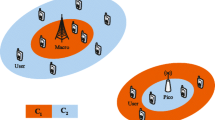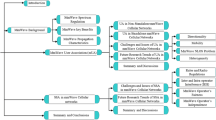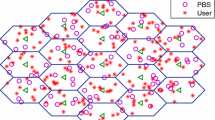Abstract
Densifying the network by adding more minicell towers or relays throughout a hot spot area while extensively reusing the available spectrum is an essential choice to improve QoS. Unfortunately, this approach can be prohibitively costly. One possible solution to reduce the capital and operating expenditure in such overdensified networks is the adoption of the spectrum-sharing approach. However, both approaches would complicate the interference phenomenon either among inter- or intraoperators, which may cause serious performance degradation. In this paper, a fully hybrid spectrum-sharing (FHSS) approach aided by an efficient cell–carrier distribution was proposed with consideration to the interference dilemma. Moreover, an adaptive hybrid QoE-based mmWave user association (mUA) scheme was presented to assign a typical user to the serving mmWave base station (mBS), which offers the highest achievable data rate. The proposed FHSS approach (with the presented QoE-based mUA) was compared with recent works and with both FHSS approach using the conventional max-SINR-based mUA, which assigns a typical user to the tagged mBS carrying the highest signal-to-interference-plus noise ratio and the baseline scenario (licensed spectrum access). In particular, three spectrum access methods (licensed, semipooled, and fully pooled) were integrated in a hybrid manner to engage improved data rates to users. Numerical results show that the joint cell–carrier distribution and FHSS approach with QoE-based mUA outperform both baselines FHSS with the max-SINR mUA scheme and the licensed spectrum access. Furthermore, results demonstrate the effectiveness of the proposed approach in terms of both operators’ independence and fairness.







Similar content being viewed by others
References
Al-khatib, O., & Hardjawana, W. (2019). Spectrum sharing in multi-tenant 5G cellular networks: Modeling and planning. IEEE Access, 7, 1602–1616.
Jiang, D., Huo, L., & Li, Y. (2018). Fine-granularity inference and estimations to network traffic for SDN. PLoS ONE, 13(5), 1–23.
Jiang, D., Huo, L., Song, H., & Member, S. (2018). Rethinking behaviors and activities of base stations in mobile cellular networks based on big data analysis. IEEE Transactions on Network Science and Engineering. https://doi.org/10.1109/tnse.2018.2861388.
Lv, Z., Kong, W., Zhang, X., Jiang, D., Lv, H., & Lu, X. (2019). Intelligent security planning for regional distributed energy internet. IEEE Transactions on Industrial Informatics. https://doi.org/10.1109/tii.2019.2914339.
Li, Y., Zhu, X., Liao, C., Wang, C., Member, S., & Cao, B. (2014). Energy efficiency maximization by jointly optimizing the positions and serving range of relay stations in cellular networks. IEEE Transactions on Vehicular Technology, 64(6), 2551–2560.
Li, Y., Liu, J., Cao, B., & Wang, C. (2018). Joint optimization of radio and virtual machine resources with uncertain user demands in mobile cloud computing. IEEE Transactions on Multimedia, 20(9), 2427–2438.
Attiah, M. L., Isa, A. A. M., Zakaria, Z., Abdulhameed, M. K., Mohsen, M. K., & Ali, I. (2019). A survey of mmWave user association mechanisms and spectrum sharing approaches: An overview, open issues and challenges, future research trends. Wireless Networks. https://doi.org/10.1007/s11276-019-01976-x.
Olwal, T. O., Djouani, K., & Kurien, A. M. (2016). A survey of resource management toward 5G radio access networks. IEEE Communications Surveys & Tutorials, 18(3), 1656–1686.
Sakaguchi, K., Haustein, T., Barbarossa, S., Strinati, E. C., Clemente, A., Destino, G., et al. (2017). Where, when, and how mmWave is used in 5G and beyond. IEICE Transactions on Electronics, 100(10), 790–808.
Alsharif, M. H., & Nordin, R. (2017). Evolution towards fifth generation (5G) wireless networks: Current trends and challenges in the deployment of millimetre wave, massive MIMO, and small cells. Telecommunication Systems, 64(4), 617–637.
Li, Y. U. N., Zhang, H. E., Wang, J., Cao, B. I. N., Liu, Q., & Daneshmand, M. (2019). Energy-efficient deployment and adaptive sleeping in heterogeneous cellular networks. IEEE Access, 7, 35838–35850.
Zhang, H., Huang, S., Jiang, C., Long, K., Leung, V. C. M., & Poor, H. V. (2017). Energy efficient user association and power allocation in millimeter-wave-based ultra dense networks with energy harvesting base stations. IEEE Journal on Selected Areas in Communications, 35(9), 1936–1947.
Li, Y., Liao, C., Wang, Y., Wang, C., Communications, I., Engineering, I., et al. (2015). Energy-efficient optimal relay selection in cooperative cellular networks based on double auction. IEEE Transactions on Wireless Communications, 14(8), 4093–4104.
Li, Y., Zhang, Z., Wang, C., Member, S., Zhao, W., & Chen, H. (2013). Blind cooperative communications for multihop ad hoc wireless networks. IEEE Transactions on Vehicular Technology, 62(7), 3110–3122.
Liu, D., Wang, L., Chen, Y., Elkashlan, M., Wong, K.-K., Schober, R., et al. (2016). User association in 5G networks: A survey and an outlook. IEEE Communications Surveys & Tutorials, 18(2), 1018–1044.
Rappaport, T. S., Sun, S., Mayzus, R., Zhao, H., Azar, Y., Wang, K., et al. (2013). Millimeter wave mobile communications for 5G cellular: It will work! IEEE Access, 1, 335–349.
Andrews, J. G., Bai, T., Kulkarni, M., Alkhateeb, A., Gupta, A., & Heath, R. W. (2017). Modeling and analyzing millimeter wave cellular systems. IEEE Transactions on Communications, 65(1), 403–430.
Niu, Y., Li, Y., Jin, D., Su, L., & Vasilakos, A. V. (2015). A survey of millimeter wave communications (mmWave) for 5G: Opportunities and challenges. Wireless Networks, 21(8), 2657–2676.
Wang, F., Jiang, D., & Qi, S. (2019). An adaptive routing algorithm for integrated information networks. China Communications, 16(7), 195–206.
Jiang, D., Huo, L., Lv, Z., Song, H., Member, S., & Qin, W. (2017). A joint multi-criteria utility-based network selection approach for vehicle- to-infrastructure networking. IEEE Transactions on Intelligent Transportation Systems, 19(10), 3305–3319.
Boccardi, F., Shokri-Ghadikolaei, H., Fodor, G., Erkip, E., Fischione, C., Kountouris, M., et al. (2016). Spectrum pooling in mmWave networks: opportunities, challenges, and enablers. IEEE Communications Magazine, 54(11), 33–39.
Rebato, M., & Zorzi, M. (2018). A Spectrum sharing solution for the efficient use of mmWave bands in 5G cellular scenarios. In 2018 IEEE International Symposium on Dynamic Spectrum Access Networks (DySPAN) (pp.1–5).
Galiotto, C., Papageorgiou, G. K., Voulgaris, K., Butt, M. M., & Member, S. (2018). Unlocking the deployment of spectrum sharing with a policy enforcement framework. IEEE Access, 6, 11793–11803.
Zhao, N., Yu, F. R., Member, S., Sun, H., & Member, S. (2015). Adaptive power allocation schemes for spectrum sharing in interference alignment (IA)-based cognitive radio networks. IEEE Transactions on Vehicular Technology, 65(5), 3700–3714.
Gurjar, D. S., & Upadhyay, P. K. (2017). Overlay spectrum sharing for device-to-device communications in two-way cellular networks with nodes mobility. Transactions on Emerging Telecommunications Technologies, 28(10), 1–11.
Li, S., & Nallanathan, A. (2019). Spectrum detection and link quality assessment for heterogeneous shared access networks. IEEE Transactions on Vehicular Technology, 68(2), 1431–1445.
Attiah, M. L., Isa, A. A. M., Zakaria, Z., Abdulhameed, M. K., Mohsen, M. K., & Dinar, A. M. (2019). Independence and fairness analysis of 5G mmWave operators utilizing spectrum sharing approach. Mobile Information Systems, 4370847, 1–12.
Samdanis, K., Costa-Perez, X., & Sciancalepore, V. (2016). From network sharing to multi-tenancy: The 5G network slice broker. IEEE Communications Magazine, 54(7), 32–39.
Jiang, D., Wang, W., Shi, L., & Song, H. (2018). A compressive sensing-based approach to end-to-end network traffic reconstruction. IEEE Transactions on Network Science and Engineering. https://doi.org/10.1109/tnse.2018.2877597.
Lertsinsrubtavee, A., & Malouch, N. (2016). Hybrid spectrum sharing through adaptive spectrum handoff and selection. IEEE Transactions on Mobile Computing, 15(11), 2781–2793.
Feng, W., Li, Y., Jin, D., Su, L., & Chen, S. (2016). Millimetre-wave backhaul for 5G networks: Challenges and solutions. Sensors (Switzerland), 16(6), 1–17.
Tehrani, R. H., Vahid, S., Triantafyllopoulou, D., Lee, H., & Moessner, K. (2016). Licensed spectrum sharing schemes for mobile operators: A survey and outlook. IEEE Communications Surveys & Tutorials, 18(4), 2591–2623.
Chen, B., Chen, Y., Chen, Y., Cao, Y., Zhao, N., & Ding, Z. (2018). A novel spectrum sharing scheme assisted by secondary NOMA relay. IEEE Wireless Communications Letters, 7(5), 732–735.
Li, G., Irnich, T., & Shi, C. (2014). Coordination context-based spectrum sharing for 5G millimeter-wave networks. In 2014 9th International Conference on Cognitive Radio Orient-ed Wireless Networks and Communications (CROWNCOM), (pp. 32–38).
Park, J., Andrews, J. G., & Jr, R. W. H. (2018). Inter-operator base station coordination in spectrum-shared millimeter wave cellular networks. IEEE Transactions on Cognitive Communications and Networking, 4(3), 513–528.
Rebato, M., Boccardi, F., Mezzavilla, M., Rangan, S., & Zorzi, M. (2017). Hybrid spectrum sharing in mmWave cellular networks. IEEE Transactions on Cognitive Communications and Networking, 3(2), 155–168.
Gupta, A. K., Andrews, J. G., & Heath, R. W. (2016). On the feasibility of sharing spectrum licenses in mmWave cellular systems. IEEE Transactions on Communications, 64(9), 3981–3995.
Rebato, M., Mezzavilla, M., Rangan, S., & Zorzi, M. (2016). Resource sharing in 5G mmWave cellular networks. In 2016 IEEE Conference on Computer Communications Work-shops (INFOCOM WKSHPS) (pp. 271–276).
Rebato, M., Boccardi, F., Mezzavilla, M., Rangan, S., & Zorzi, M. (2016). Hybrid spectrum access for mmWave networks. In 2016 Mediterranean Ad Hoc Networking Workshop (Med-Hoc-Net) (pp. 1–7).
Jurdi, R., Gupta, A. K., Andrews, J. G., & Heath, R. W. (2018). Modeling infrastructure sharing in mmWave networks with shared spectrum licenses. IEEE Transactions on Cognitive Communications and Networking, 4(2), 328–343.
Fund, F., Shahsavari, S., Panwar, S. S., Erkip, E., & Rangan, S. (2017). Resource sharing among mmWave cellular service providers in a vertically differentiated duopoly. In 2017 IEEE International Conference on Communications (ICC) (pp. 1–7).
Rebato, M., Mezzavilla, M., Rangan, S., & Zorzi, M. (2017). Hybrid spectrum sharing in mmWave cellular netwroks. IEEE Transactions on Cognitive Communications and Networking, 3(2), 155–168.
Weiler, R. J., Peter, M., Keusgen, W., Calvanese-strinati, E., Domenico, A. De, Filippini, I., et al. (2014). Enabling 5G Backhaul and Access with millimeter-waves. In EuCNC 2014-European Conference on Networks and Communications (pp. 1–5).
Qiu, Y., Zhang, H., Long, K., Huang, Y., Song, X., & Leung, V. C. M. (2018). Energy-efficient power allocation with interference mitigation in mmWave-based fog radio access networks. IEEE Wireless Communications, 25(4), 25–31.
Rappaport, T. S., Gutierrez, F., Ben-Dor, E., Murdock, J. N., Qiao, Y., & Tamir, J. I. (2013). Broadband millimeter-wave propagation measurements and models using adaptive-beam antennas for outdoor Urban cellular communications. IEEE Transactions on Antennas and Propagation, 61(4), 1850–1859.
Rappaport, T. S., Maccartney, G. R., Member, S., Samimi, M. K., Sun, S., & Member, S. (2015). Wideband millimeter-wave propagation measurements and channel models for future wireless communication system design. IEEE Transactions on Communications, 63(9), 3029–3055.
Bhushan, N., Li, J., Malladi, D., Gilmore, R., Brenner, D., Damnjanovic, A., et al. (2014). Network densification: The dominant theme for wireless evolution into 5G. IEEE Communications Magazine, 52(2), 82–89.
Sun, M., Jiang, D., Song, H., & Liu, Y. (2017). Statistical resolution limit analysis of two closely spaced signal sources using rao test. IEEE Access, 5, 22013–22022.
Rappaport, T. S., Murdock, J. N., & Gutierrez, F. (2011). State of the art in 60-GHz integrated circuits and systems for wireless communications. Proceedings of the IEEE, 99(8), 1390–1436.
Miao, L., Xu, L., & Jiang, D. (2019). Optimal on-off control for a class of discrete event systems with real-time constraints. Discrete Event Dynamic Systems, 29(1), 79–90.
Andrews, J. G. (2013). Seven ways that HetNets are a cellular paradigm shift. IEEE Communications Magazine, 51(3), 136–144.
Hoßfeld, T., Skorin-Kapov, L., Heegaard, P. E., & Varela, M. (2018). A new QoE fairness index for QoE management. Quality and User Experience, 3(1), 1–23.
Hobfeld, T., Skorin-Kapov, L., Heegaard, P. E., & Varela, M. (2017). Definition of QoE fairness in shared systems. IEEE Communications Letters, 21(1), 184–187.
Capozzi, F., Piro, G., Grieco, L. A., Boggia, G., & Camarda, P. (2013). Downlink packet scheduling in LTE cellular networks: Key design issues and a survey. IEEE Communications Surveys and Tutorials, 15(2), 678–700.
Acknowledgements
The authors gratefully acknowledge UTeM Zamalah Scheme, Universiti Teknikal Malaysia Melaka (UTeM), and the support from the Centre for Research and Innovation Management (CRIM), Centre of Excellence, Universiti Teknikal Malaysia Melaka (UTeM).
Author information
Authors and Affiliations
Corresponding author
Additional information
Publisher's Note
Springer Nature remains neutral with regard to jurisdictional claims in published maps and institutional affiliations.
Rights and permissions
About this article
Cite this article
Attiah, M.L., Isa, A.A.M., Zakaria, Z. et al. Joint QoE-based user association and efficient cell–carrier distribution for enabling fully hybrid spectrum sharing approach in 5G mmWave cellular networks. Wireless Netw 25, 5027–5043 (2019). https://doi.org/10.1007/s11276-019-02109-0
Published:
Issue Date:
DOI: https://doi.org/10.1007/s11276-019-02109-0




